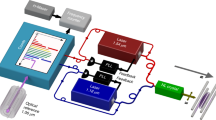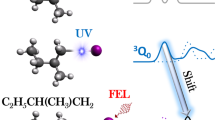Abstract.
A high-frequency laser (λ<40 nm) can ionize the H2 + molecule via a one-photon transition to the electron–nuclei continua. From exact non-Born–Oppenheimer simulations of dynamics of H2 + in intense laser fields we show that it is possible to reconstruct the shape of the initial, stationary vibrational wave function |ψv(R)|2 by measuring kinetic energy spectra of either protons or electrons. The reconstruction procedure from proton spectra is based on a perturbative one-photon transition to the electron–proton continua and formally is similar to the previously discussed laser Coulomb explosion imaging technique. For sufficiently high explosion energy, proton spectra are directly proportional to |ψv(q2/EN)|2, where EN is the nuclear energy. Alternatively, one can measure kinetic energy of electrons, from which the proton energy can be deduced via the conservation of energy for a one-photon transition to the electron–proton continuum, and thus the shape of the first peak in the electron spectrum is also directly proportional to the initial vibrational probability distribution. We compare these two methods and also compare them with the previously proposed imaging methods based on Coulomb explosions induced by multiphoton transitions. We find that high-frequency lasers allow us to perform the imaging of a stationary wave function with longer and less intense pulses than pulses required in the previously discussed long-wavelength regime. Imaging based on electron spectra requires longer pulses, since the spread of photon energy in short pulses does not allow us to determine nuclear energy, in an accurate way, via conservation of energy. In general, the photo-electron spectra from H2 + are found to be very different from atomic spectra, the latter having much narrower peaks, while the former are greatly enlarged due to sharing the final energy with nuclei. The photo-electron and nuclear spectra show a very clear imprint of the nuclear wave function, e.g. if the molecule is prepared in the v-state that has v nodes, both spectra will also have v nodes.
Similar content being viewed by others
Author information
Authors and Affiliations
Additional information
Received: 14 September 2001 / Revised version: 7 November 2001 / Published online: 20 June 2002
Rights and permissions
About this article
Cite this article
Chelkowski, S., Bandrauk, A. Measuring molecular wave functions using laser Coulomb explosion imaging with ultraviolet lasers. Appl Phys B 74 (Suppl 1), s113–s120 (2002). https://doi.org/10.1007/s00340-002-0874-z
Published:
Issue Date:
DOI: https://doi.org/10.1007/s00340-002-0874-z




